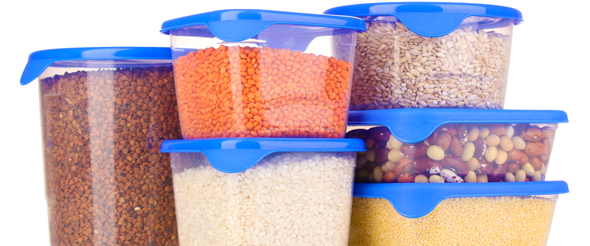 There are many types of food storage containers out there and materials from which they are made. The right option for a food business is usually to have a wide variety of shapes, sizes, and materials on hand, to meet the changing demands daily. However, environmental and health concerns associated with plastic materials should be considered as well.
There are many types of food storage containers out there and materials from which they are made. The right option for a food business is usually to have a wide variety of shapes, sizes, and materials on hand, to meet the changing demands daily. However, environmental and health concerns associated with plastic materials should be considered as well.
Types of Material
First, let’s take a look at the types of material available: plastic, glass, stainless steel, and aluminum are all available options, but glass and plastic are probably the most common, so we will focus on those. Plastic raises many concerns for environmentalists and the health-conscious alike. Not only are many types of plastic non-biodegradable, some can also release harmful chemicals into foods. Even those containers with “microwave-safe” labels doesn’t mean that it is 100% free of these harmful materials. Plastic can have astonishing effects on the environment. According to a 2012 survey by the Environmental Protection Agency, 32 million tons of plastic waste were generated that year, with only 9% recovered for recycling. Plastic products are usually labeled with a number between one and seven, which symbolizes the resin with which the plastic was made. Among the types used, PET and HDPE, or numbers 1 and 2, are the most commonly recycled. However, surveys show that the recycling rate is relatively low, posing a threat to the environment. “Green” food businesses should recycle plastic waste, but in terms of food storage containers, they may want to consider minimizing the amount of plastic used, especially in take-away meals.
Having plastic food bins that will not be thrown away any time soon may be useful and convenient, but when it comes to disposable goods like utensils in take-away food, businesses may want to consider alternative options. Due to the health and environmental concern associated with plastic, food businesses may do better using glass as an alternative option.
Containers
Now let’s take a look at the types of food storage containers available. Often, plastic food boxes are offered for packaging take-away food. These can be replaced with paper options (such as bento boxes) to prevent chemical release into the foods from the plastic. Ingredient bins for storing dry goods are often made from plastic as well. The plastic provides a sealed, lightweight, stackable, and inexpensive option for quick access to raw ingredient supply during food preparation. Though plastic boxes are often detrimental to the environment and may have health repercussions, purchasing PCB and BPA-free options made from recyclable plastic, when available, can minimize such concerns. Ziploc® bags are good options for storing food as well. Aiming to purchase either glass containers or BPA-free plastics such as Ziploc® products puts health at the forefront, while providing a convenient storage solution. Canisters can be a useful option for storing spices and sugar, and can be found in a wide range of materials, providing flexibility for businesses to choose which type suits them. Glass jars for pickling and storing liquids and jams can also be useful for a venue. However, jars are less important for every venue than good food storage containers, since not all venues prepare preserves and pickled foods. Since food businesses tend to change their menus periodically, and cannot predict the exact amounts and types of food that will have to be stored on a given day, they should have many food storage containers on hand, in different materials, shapes, and sizes.
Having a wide variety of sizes and types of food storage containers should not be negotiated. However, the materials they are made of can be chosen by the business, for better or for worse. Though budget should be taken into consideration, environmental and health concerns should be weighed as well. Opting for glass options as opposed to plastic, when available and convenient, can be a great strategy for reducing the health concerns related to plastic, in the venue.
Good write-up. I absolutely love this site. Keep writing!
Ahaa, its good dialogue on tthe topic of this piece of writing at this place at this
weblog, I have read all that, so at thus time me also commenting here.